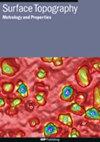通过确定性混合润滑模拟评估铬涂层气缸套的表面纹理
IF 2
3区 材料科学
Q2 ENGINEERING, MECHANICAL
引用次数: 0
摘要
本研究采用确定性混合润滑模型,研究了二冲程内燃机活塞环/气缸套结合处各种表面纹理配置的混合润滑性能。该数值模型同时求解了具有质量保证空化的雷诺方程,以计算表面间的流体动力压力,并同时求解了弹性、完全塑性、粗糙接触模型,以确定每个表面相互作用处的接触压力。采用高斯混合模型聚类来增强表面特征。确定性模拟方法考虑了气缸套形貌的全尺寸表示,以准确捕捉混合润滑条件下表面特征对流体动力支持和摩擦的影响。所研究的气缸套最初经过硬铬涂层和珩磨,形成了随机的表面孔隙排列,然后通过微型放电加工(EDM)形成了确定的表面凹槽图案。使用激光干涉仪进行表面测量,为混合润滑模拟提供输入。该研究还探讨了电火花加工技术对凹槽周围形成的脊的虚拟去除。主要研究结果表明,随机纹理在边界润滑和混合润滑状态下的表现优于混合纹理(随机+确定),在低分离度时显示出更高的流体动力支持,但在高速时流体动力剪切应力增加。相反,确定性纹理在高速时平均流体动力剪切应力显著降低。这些结果凸显了表面纹理在摩擦学行为中的关键作用,并表明气缸套上的局部纹理有可能优化发动机性能。研究建议进一步探索更广泛的纹理几何形状、密度和分布模式,以改进发动机设计策略。本文章由计算机程序翻译,如有差异,请以英文原文为准。
Evaluation of surface texturing on chrome-coated cylinder liners via deterministic mixed lubrication simulation
This study investigates the mixed lubrication performance of various surface texture configurations in the piston ring/cylinder liner conjunction of a two-stroke internal combustion engine using a deterministic mixed lubrication model. The numerical model simultaneously solves the Reynolds equation with mass-conserving cavitation to calculate inter-asperity hydrodynamic pressures and an elastic, perfectly plastic, rough contact model to determine contact pressures at each asperity interaction. Gaussian Mixture Model clustering was employed to enhance surface characterization. The deterministic simulation approach considers the full-scale representation of the cylinder liner topography to accurately capture the influence of surface features on the hydrodynamic support and friction under mixed lubrication conditions. The investigated cylinder liners were initially hard-chrome-coated and honed, resulting in a stochastic arrangement of surface pores, and then deterministic patterns of surface pockets were created by micro electrodischarge machining (EDM). Surface measurements were performed using laser interferometry, providing input for the mixed lubrication simulations. The study also explored the virtual removal of ridges formed around the pockets by the EDM technique. Key findings indicate that the stochastic texture outperformed the hybrid texture (stochastic + deterministic) in the boundary and mixed lubrication regimes, showing higher hydrodynamic support at low separations but increased hydrodynamic shear stresses at higher speeds. Conversely, deterministic textures exhibited a significant decrease in average hydrodynamic shear stress at high velocities. These results highlight the critical role of surface texture in tribological behavior and suggest that localized textures on cylinder liners can potentially optimize engine performance. The study recommends further exploration of a broader range of texture geometries, densities, and distribution patterns to enhance engine design strategies.
求助全文
通过发布文献求助,成功后即可免费获取论文全文。
去求助
来源期刊

Surface Topography: Metrology and Properties
Materials Science-Materials Chemistry
CiteScore
4.10
自引率
22.20%
发文量
183
期刊介绍:
An international forum for academics, industrialists and engineers to publish the latest research in surface topography measurement and characterisation, instrumentation development and the properties of surfaces.
 求助内容:
求助内容: 应助结果提醒方式:
应助结果提醒方式:


